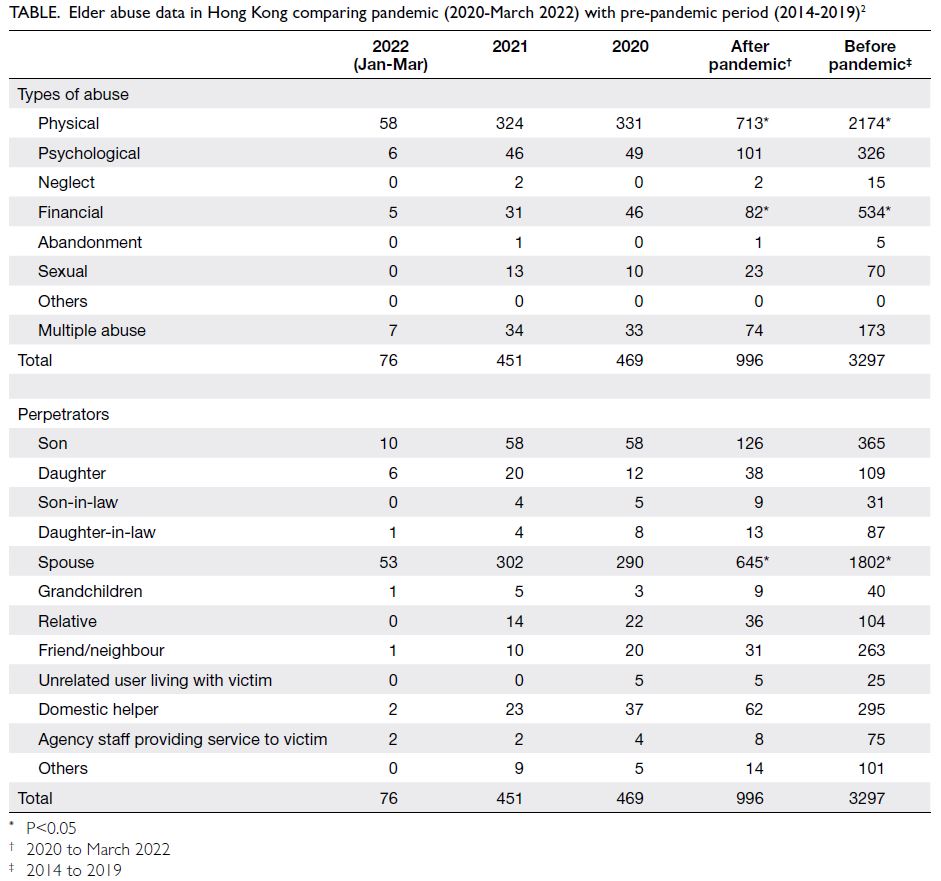Hong Kong Med J 2022;28(6):502–3 | Epub 25 Oct 2022
© Hong Kong Academy of Medicine. CC BY-NC-ND 4.0
LETTER TO THE EDITOR
Comparison of the pattern of elderly abuse in
Hong Kong before and after the COVID-19 pandemic
YF Shea, FHKAM (Medicine); Whitney CT Ip, MRCP (UK); James KH Luk, FHKAM (Medicine)
Department of Medicine, Queen Mary Hospital, Hong Kong
Corresponding author: Dr YF Shea (elphashea@gmail.com)
To the Editor—We have previously published our
observations on changes to the pattern of elderly
abuse in 2020 (during the coronavirus disease
2019 [COVID-19] pandemic) compared with the
pre-pandemic period.1 There was a proportionate
increase in physical abuse with the spouse as
perpetrator. With the publication of additional data
by the Social Welfare Department, we have obtained
further data relating to elder abuse between 2014
and March 2022 (n=4293).2 We compared data
reported during the COVID-19 pandemic from 2020
to March 2022 (n=996) with pre-pandemic data (from 2014 to 2019, n=3297). The abuse methods
and identity of perpetrator were compared using Chi
squared statistics. The data are summarised in the
Table.

Table. Elder abuse data in Hong Kong comparing pandemic (2020-March 2022) with pre-pandemic period (2014-2019)2
There was proportionately more physical
abuse (71.6% vs 65.9%, χ2=11.0774, P=0.009) but less
financial abuse (8.2% vs 16.2%, χ2=39.4716, P<0.001)
during the pandemic compared with the pre-pandemic
period. Regarding the perpetrators, there
were proportionately more spouses (64.8% vs 54.7%,
χ2=31.8566, P<0.001). There was no difference in the
pattern of elderly abuse or identity of perpetrators within the COVID-19 pandemic period (ie, 2020 to March 2022).
We continued to observe proportionately more
physical abuse with the spouse as perpetrator during
the pandemic. It is likely the initially low vaccination
uptake among older adults and COVID-19 outbreak
meant the older adults were more likely to remain
at home. There were insufficient opportunities for
recreational activities or social support. A spouse,
often the only co-habitee, had more opportunities
to inflict abuse. Government and social welfare
organisations should be alerted to this change.
Author contributions
All authors contributed to the drafting of the letter and critical revision for important intellectual content. All
authors approved the final version for publication and take
responsibility for its accuracy and integrity.
Conflicts of interest
As an editor of the journal, JKH Luk was not involved in the peer review process. Other authors have disclosed no conflicts of interest.
Funding/support
This letter received no specific grant from any funding agency in the public, commercial, or not-for-profit sectors.
References
1. Ip CT, Shea YF, Chan HW, Luk KH. Changes in pattern of elderly abuse during COVID-19 pandemic.
Psychogeriatrics 2022;22:286-7. Crossref
2. Social Welfare Department, Hong Kong SAR Government.
Services for prevention and handling of elder abuse. 2022.
Available from: https://www.swd.gov.hk/en/index/site_pubsvc/page_elderly/sub_csselderly/id_serabuseelder/.Accessed 12 May 2022.

